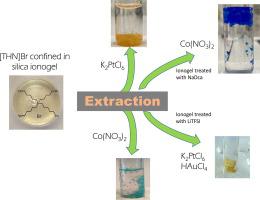Separation and Purification Technology ( IF 8.1 ) Pub Date : 2023-06-08 , DOI: 10.1016/j.seppur.2023.124285 Stéphanie BOUDESOCQUE , Lydie VIAU , Habiba NOUALI , Laurent DUPONT

|
In this study, we have explored a strategy to develop new ionogels as materials for metal extraction. The methodology applied here consists, first, in confining a commercial salt tetrahexylammonium bromide [THN]Br in silica-based ionogels in order to determine their extracting properties. Anionic metathesis was then carried out in-situ on the [THN]Br ionogels with sodium dicyanamide (NaDca) or lithium bis(trifluoromethanesulfonyl)imide (LiTFSI) to enhance their extracting efficiency or to bring selectivity to the extraction process. Treatment of [THN]Br ionogels with those salts ensures a quasi-quantitative replacement of bromide ions by Dca- and TFSI-. The replacement of bromide anions was confirmed by thermogravimetric analyses (TGA) and Infra-Red spectroscopy. Nitrogen adsorption-desorption isotherms measured before and after metathesis allow us to confirm that no major structural modification has been induced by the anionic exchange.
[THN]Br ionogels were used for the extraction of Au(III), Pt(IV), Co(II), and Cr(VI). Au(III), Pt(IV) and Cr(VI) were fully extracted while the extraction of Co(II) did not exceed a few percent. Treatment of [THN]Br ionogels with NaDca improved the extraction capabilities of the material with respect to Co(II) while treatment with LiTFSI allowed the separation of Au(III) from Pt(IV), with separation factors higher than 1000. It also increased the separation of Au(III) from Cu(II) compared to the brominated ionogel. The extraction performances of each ionogel were compared to those of the pure similar ionic liquid. This work shows that, starting from the same ionogel, the extracting properties can be modulated as desired by simple anion exchange.
中文翻译:

离子凝胶作为金属提取的模块化平台
在这项研究中,我们探索了一种开发新型离子凝胶作为金属提取材料的策略。这里应用的方法包括,首先,将商业盐四己基溴化铵 [THN]Br 限制在二氧化硅基离子凝胶中,以确定它们的提取特性。然后使用双氰胺钠 (NaDca) 或双(三氟甲磺酰基)亚胺锂 (LiTFSI) 在 [THN]Br 离子凝胶上原位进行阴离子复分解,以提高其提取效率或提高提取过程的选择性。用这些盐处理 [THN]Br 离子凝胶可确保溴离子被 Dca -和 TFSI -准定量替代. 通过热重分析 (TGA) 和红外光谱证实了溴化物阴离子的置换。在复分解之前和之后测量的氮吸附-脱附等温线使我们能够确认阴离子交换没有引起主要的结构改变。
[THN]Br 离子凝胶用于提取 Au(III)、Pt(IV)、Co(II) 和 Cr(VI)。Au(III)、Pt(IV) 和 Cr(VI) 被完全提取,而 Co(II) 的提取不超过百分之几。用 NaDca 处理 [THN]Br 离子凝胶提高了材料对 Co(II) 的萃取能力,而用 LiTFSI 处理允许 Au(III) 与 Pt(IV) 分离,分离因子高于 1000。它还与溴化离子凝胶相比,增加了 Au(III) 与 Cu(II) 的分离。将每种离子凝胶的提取性能与纯的类似离子液体的提取性能进行了比较。这项工作表明,从相同的离子凝胶开始,可以通过简单的阴离子交换根据需要调节提取特性。











































 京公网安备 11010802027423号
京公网安备 11010802027423号